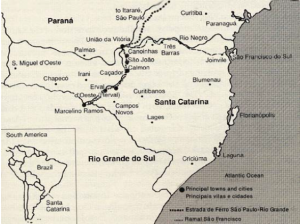The Contestado War: Brazil’s Biggest Civil War
The Contestado War was an armed conflict between the peasants and the army of the states of Santa Catarina and Paraná – a region that did not have the boundaries well defined, therefore the name Contestado – between 1912 and 1916. The construction of the railroad by the North American company Brazil Railway, which linked the city of São Paulo to Santa Maria, in Rio Grande do Sul, is considered by researchers to be one of the main reasons for the conflict.
Together with the concession for the construction of the road, the Brazil Railway Company, created by Percival Farquhar in 1906, now owns 15 kilometers of land strip on either side of the highway. This concession expelled thousands of caboclos from their lands who would have nowhere else to make a living. The large complex, in addition to working in the railroad branch, promoted the deforestation of the region for use in logging companies.
The original inhabitants of the region, who lost their lands, rebelled. They destroyed railway stations, burned Lumber, in the city of Calmon, which was part of the Company, and attacked the colonels, who represented the state. The war left approximately 8,000 dead, mostly poor peasants from the Contestado region.
The map below shows the State of Santa Catarina, and the path taken by the railroad in dotted, with the cities of the region in focus.

Source: DIACON, Todd A. Millenarian vision, capitalist reality – Brazil’s Contestado Rebelion, 1912-1916. 4 ed., Durham and London: Duke University Press, 2002. p. 47.
Reference:
VALENTINI, Delmir José. Atividades da Brazil Railway Company no sul do Brasil: A instalação da Lumber e a Guerra na região do Contestado (1906-1916). PUCRS. Porto Alegre, 2009. Disponível em: <http://tede2.pucrs.br/tede2/handle/tede/2277>. Acesso em: 15 abr. 2020.
Text by Karen Wesseler Jung.










